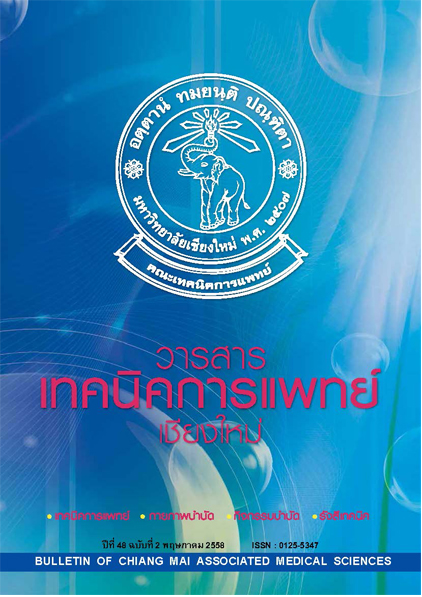High plasma levels of soluble tumor necrosis factor receptor type II (sTNFRII) but low plasma levels of soluble FasL (sFasL) in patients with severe pandemic H1N1 2009 influenza infectio
Main Article Content
Abstract
Background: Inflammatory mediators play an important role in immune responses to viral infections. Data on the plasma levels of inflammatory mediators in pandemic H1N1 2009 influenza virus-infected Thai patients with severe diseases remain very limited.
Objective: To assess plasma levels of interleukin-1b (IL-1b), IL-2, IL-4, IL-5, IL-6, IL-7, IL-8, IL-10, IL-12 (p70), IL-13, IL-17, granulocyte-colony stimulating factor (G-CSF), granulocyte-macrophage colony-stimulating factor (GM-CSF), monocyte chemoattractant protein-1 (MCP-1), macrophage inflammatory protein (MIP)-1b, interferon-gamma (IFN-g), tumor necrosis factor-a (TNF-a), sTNFRII, sFasL and soluble RAGE (sRAGE) in patients with pandemic H1N1 2009 influenza infection.
Methods: Forty-two patients with pandemic H1N1 2009 influenza infection characterized as mild disease (n=21) or severe disease (n=21) were enrolled in this study. The study protocol was approved by the Ethical Committee of the Institute for the Development of Human Research Protection (IHRP), Ministry of Public Health. The study was carried out in Nakhon Ratchasima province during August 2009 to November 2010. Plasma levels of IL-1b, IL-2, IL-4, IL-5, IL-6, IL-7, IL-8, IL-10, IL-12 (p70), IL-13, IL-17, G-CSF, GM-CSF, MCP-1, MIP-1b, IFN-g and TNF-a were measured using Bio-Plex Pro™ Human Cytokine 17-plex Assay (Bio-Rad). Plasma levels of sTNFRII, sFasL and sRAGE were determined by sandwiched enzyme-linked immunosorbent assay (R&D).
Result: Plasma levels of sTNFRII in pandemic H1N1 2009 influenza-infected patients with severe diseases (median (IQR) (pg/mL); 7,525 (6,470-9,630); n=11) were significantly higher than those with mild diseases (median (IQR) (pg/mL); 3,692 (2,655-4,128); n=21) (p=0.004). In addition, plasma levels of sFasL in pandemic H1N1 2009 influenza virus-infected patients with severe disease (median (IQR) (pg/mL); 39 (10-78); n=21) were significantly lower than those with mild disease (median (IQR) (pg/mL); 10 (10-25); n=11) (p=0.003). However, the plasma levels of IL-1b, IL-2, IL-4, IL-5, IL-6, IL-7, IL-8, IL-10, IL-12 (p70), IL-13, IL-17, G-CSF, GM-CSF, MCP-1, MIP-1b, IFN-g, TNF-a, and sRAGE did not show any significant difference between the severe pandemic H1N1 2009 influenza virus infection and mild pandemic H1N1 2009 influenza virus infection.
Conclusion: The finding showed that higher plasma sTNFRII and lower plasma sFasL levels in patients with severe pandemic 2009 influenza virus infection might determine dysregulation of host immune response and could be used as prognostic markers of disease severity.
Bull Chiang Mai Assoc Med Sci 2015; 48(2): 115-126. Doi: 10.14456/jams.2015.12
Article Details
Personal views expressed by the contributors in their articles are not necessarily those of the Journal of Associated Medical Sciences, Faculty of Associated Medical Sciences, Chiang Mai University.


